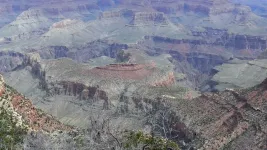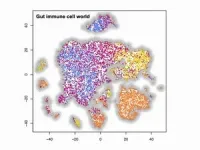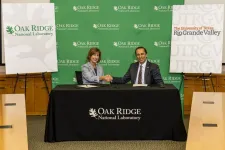(Press-News.org) The Grand Canyon’s valleys and millions of years of rock layers spanning Earth’s history have earned it a designation as one of the Seven Natural Wonders of the World. But, according to a new UNLV and University of New Mexico study, its marvels extend to vast cave systems that lie beneath the surface, which just might hold clues to better understand the future of climate change — by studying nature’s past.
A research team led by UNLV paleoclimatologist and Professor Matthew Lachniet that included the University of New Mexico Department of Earth & Planetary Sciences Distinguished Professor Yemane Asmerom and Research Scientist Victor Polyak and other collaborators, studied an ancient stalagmite from the floor of an undisturbed Grand Canyon cave. By studying the mineral deposits’ geochemistry, they were able to analyze precipitation patterns during the rapidly warming period following the last Ice Age to improve understanding of the potential impact of future climate change on summer monsoon rains in the U.S. Southwest and northwestern Mexico.
Their findings, “Elevated Grand Canyon groundwater recharge during the warm Early Holocene,” published Oct. 2 in Nature Geoscience, revealed that increasing levels of water seeped into the cave between 8,500 and 14,000 years ago, during a period known as the early Holocene when temperatures rose throughout the region. Using a paleoclimate model, the researchers determined that this was likely caused by intensified and expanded summer rainfall stemming from atmospheric impacts on air circulation patterns that more quickly melted the winter snowpacks and sped up the evaporation process that fuels monsoon rains.
This is significant, authors say, because most of the water currently infiltrating through the bedrock and into caves and aquifers — and contributing to groundwater recharge — comes from winter snowmelt. During the early Holocene, however, when peak temperatures were only slightly warmer than today, both summer and winter moisture contributed to groundwater recharge in the region.
The authors suggest that future warming, which could cause temperatures to rise above those of the early Holocene, may also lead to greater rates of summer rainfall on the high-elevation Colorado Plateau and an intensifying North American monsoon, the pattern of pronounced and increased thunderstorms and precipitation that typically occur between June and mid-September.
“What was surprising about our results is that during this past warm period, both the summer monsoon and infiltration into the cave increased, which suggests that summer was important for Grand Canyon groundwater recharge, even though today it is not an important season for recharge,” said Lachniet, who personally retrieved the stalagmite from a cave in the Redwall Formation on the South Rim of eastern Grand Canyon in 2017. “While we still expect the region to dry in the future, more intense summer rainfall may actually infiltrate into the subsurface more than it does today.”
Stalagmites are common cave formations that act as ancient rain gauges that record historic climate change. They grow as mineral-rich waters seep through the ground above and drop from the tips of stalactites on cave ceilings. Calcite minerals from tiny drops of water accumulate over thousands of years and, much like tree rings, accurately record the rainfall history of an area. Three natural forms of oxygen are found in water, and the quantity of one form decreases as rainfall increases. This information is
locked into the stalagmites over time. Because of the distinct difference in the oxygen isotope composition between summer and winter precipitation, it is possible to estimate the relative contributions from each season. Variation in uranium 234 isotope and changes in the growth thickness of stalagmite give indication of the change in the amount of precipitation.
“We were able to validate the oxygen record with the growth data, with the uranium isotope data to confirm that in fact, we see significant increases in summer moisture during this warm period, which we attribute is to the monsoon,” said Asmerom. “Obviously, we know things very precisely in terms of timing because we know how to date things. This is something that we are known for around the world using these methods”, Polyak added.
The research team used stalagmite samples to reconstruct groundwater recharge rates — or the amount of water that penetrates the aquifers — in the Grand Canyon area during the early years of the Holocene period. High groundwater recharge rates likely occurred on other high-elevation plateaus in the region, too, they said, though it’s unclear how the activity applies to hotter, low-elevation deserts.
What is clear is that ongoing human-caused climate change is leading to hotter temperatures throughout southwestern North America, including the Grand Canyon region. Alongside population growth and agricultural pressures, this warming can reduce the infiltration of surface water into groundwater aquifers. Groundwater recharge rates also depend on the frequency and intensity of summer rains associated with monsoon season.
Though summer infiltration isn’t a significant contributor to groundwater recharge in the region today, these latest findings suggest that could change in the future as the climate warms and monsoonal moisture increases. What’s unknown is how a projected decrease in winter precipitation and snowpack could impact overall groundwater reserves.
In a previous study led by UNM’s Asmerom and published in the Proceedings of the National Academy of Sciences, they found that the North American monsoon is likely to intensify with increased warming. But there were other, mostly model-based studies that suggested otherwise. The new study is consistent with Asmerom and colleagues’ previous study.
“Unfortunately, effective moisture is the balance between precipitation and evaporation. Unlike the more temperate Grand Canyon climate, the dry southern part, is likely to be drier, as a result of the increased temperatures,” said Asmerom.
END
Scientists investigate Grand Canyon's ancient past to predict future climate impacts
UNLV, UNM team up to explore the relationship between global warming and the strength of the North American Monsoon
2023-10-06
ELSE PRESS RELEASES FROM THIS DATE:
ESMO Congress 2023
2023-10-06
Lugano, Switzerland, 6 October 2023 – Under the promise to “Disseminating innovative research for optimal cancer care” as this year’s tagline reads, the ESMO Congress 2023 will be held in Madrid between 20-24 October 2023 with a virtual component to allow as many people as possible to attend.
From a keynote lecture pinpointing the hallmarks of cancer in the current year through the reinforced commitment towards more academic input in the drug development process for better cancer care, and then further down to the dramatic scenarios brought by the too many situations of crisis in the world which have an unbearable impact ...
ORNL, University of Texas Rio Grande Valley partner to provide students research, mentorship opportunities
2023-10-06
The Department of Energy’s Oak Ridge National Laboratory and the University of Texas Rio Grande Valley, known as UTRGV, have signed a memorandum of understanding to strengthen research cooperation and establish a collaborative program for undergraduate research and education, further cementing relationships and collaboration between the lab and minority-serving institutions. This partnership builds a pathway for students to pursue science, technology, engineering and mathematics, or STEM, careers through DOE by complementing ...
Lurbinectedin for Neuroendocrine Tumors (NETs)
2023-10-06
“Several ongoing trials hope to further elucidate the role of lurbinectedin in highgrade neuroendocrine neoplasms [...]”
BUFFALO, NY- October 6, 2023 – A new editorial paper was published in Oncoscience (Volume 10) on June 14, 2023, entitled, “Lurbinectedin, a DNA minor groove inhibitor for neuroendocrine neoplasms beyond small cell lung cancer.”
In their new editorial, researchers Deepak Bhamidipati and Vivek Subbiah from the Sarah Cannon Research Institute discuss lurbinectedin as a method to treat neuroendocrine tumors (NETs). NETs encompass a variety ...
Clinical trial reveals benefits of inhaled nitric oxide for patients with respiratory failure due to COVID-19 pneumonia
2023-10-06
Key Takeaways
Researchers have posted the results of a multisystem phase II clinical trial of patients with COVID-19 and respiratory failure
Patients who received inhaled nitric oxide had improved blood oxygen levels and fewer risks of long-term sensory and motor neurologic symptoms
They also experienced a faster reduction of viral load in sputum and blood
BOSTON – Inhaled nitric oxide gas widens blood vessels in the lungs and is used to treat severe cardio-pulmonary conditions in newborns and adults.
A recent multicenter international ...
nTIDE September 2023 Jobs Report: Employment trend holds steady at historic highs through early autumn for people with disabilities
2023-10-06
East Hanover, NJ – October 6, 2023 –The labor force participation and employment-to-population ratio have held relatively steady throughout the summer and into the fall for people with disabilities, while percentages for people without disabilities may have maxed out at their pre-pandemic baseline, according to today’s National Trends in Disability Employment – semi-monthly update (nTIDE), issued by Kessler Foundation and the University of New Hampshire’s Institute on Disability (UNH-IOD). In comparison, the employment-to-population ratio for people without disabilities remained flat with no change, while ...
Kidney disease gene also has a protective mutation
2023-10-06
African Americans have long been known to be at increased risk of kidney disease due to a dangerous genetic mutation that creates a hole in the kidney cells, but Vanderbilt University Medical Center (VUMC) researchers have now discovered a protective genetic mutation that covers the hole to eliminate the risk.
The findings on the apolipoprotein L1 (APOL1) gene, published today in the Journal of the American Society of Nephrology, could have immediate and broad implications for kidney health because people with both the disease-causing and protective mutation are not at increased risk.
“Our team discovered ...
Aston University offers talented Indian graduates opportunity to study for Masters degrees
2023-10-06
Aston University, UK, is offering a group of highly talented graduates of Symbiosis Institute of Technology (SIT), India the opportunity to study for a Masters degree.
The two institutions have signed a progression agreement which is designed to make it easier for top SIT graduates to apply for courses at Aston University.
The Aston-SIT partnership has been developed from the support of the British Council via its going global partnerships exploratory grant scheme. The areas of study cover a wide range of MSc programmes in engineering, physical sciences and business studies.
Aston University is in Birmingham, ...
New research led by Mays Cancer Center reveals how mutations in BRCA1 affect cancer susceptibility in women
2023-10-06
SAN ANTONIO, Oct. 6, 2023 – Three decades after discoveries linking mutations in the BRCA1 gene to breast and ovarian cancer susceptibility, research led by Mays Cancer Center at The University of Texas Health Science Center at San Antonio (UT Health San Antonio) has pinpointed the molecular mechanism by which a large portion of these mutations cause cancers in women.
The discovery, unveiled in an Oct. 4 research article in the journal Molecular Cell, is poised to assist researchers in developing drugs to battle breast and ovarian cancers and to help identify women who are at an elevated risk of developing these cancers, according to the ...
How the war in Ukraine is challenging two academic disciplines
2023-10-06
Since the beginning of Russia’s invasion of Ukraine, two academic disciplines have come to fore: peace and conflict studies and East European studies. Experts from both fields represent important voices in the public discourse. A symposium entitled ‘War and Peace in Ukraine: Reflecting, Studying and Engaging Across Disciplines” will be held from 12 until 13 October 2023 at Bielefeld University. It brings together experts from both fields in order to discuss the relationship between them and challenges of participating in a highly ...
How do our brains tell us what went wrong?
2023-10-06
Whether improperly closing a door or shanking a kick in soccer, our brains tell us when we’ve made a mistake because these sounds differ from what we expect to hear. While it’s long been established that our neurons spot these errors, it has been unclear whether there are brain cells that have only one job—to signal when a sound is unexpected or “off.”
A team of New York University neuroscientists has now identified a class of neurons—what it calls “prediction-error neurons”—that are not responsive to sounds in general, ...
LAST 30 PRESS RELEASES:
Groundbreaking discovery turns household plastic recycling into anti-cancer medication
Blocking a key inflammatory pathway improves liver structure and vascular function in cirrhosis, study finds
Continuous spread: Raccoon roundworm detected in nine European countries
HKUST Engineering researchers developed a novel photodetector to enhance the performance of on-chip light monitoring
Strategic river sensors could have forewarned of Texas Camp flood disaster
Drone sampling of whale breath reveals first evidence of potentially deadly virus in Arctic
Roman soldiers defending Hadrian’s Wall infected by parasites, study finds
Pinochet’s prisoners were tormented with music but still found solace in it, a new book reveals
Fertility remains high in rural Tanzania despite access to family planning
AI-assisted device can improve autism care access
Kinetic careers
Uncovering how parasitic plants avoid attacking themselves to improve crop resistance
Nanoparticle vaccine strategy could protect against Ebola and other deadly filoviruses
Study finds brain care score can predict risk of stroke across racial groups
Key lung immune cells can intensify allergic reactions
Do hormones explain why women experience more gut pain?
New materials conduct ions in solids as easily as in liquids
Breakthrough of the Year: Renewable energy begins to eclipse fossil fuel-based sources
LLM use is reshaping scientific enterprise by increasing output, reducing quality and more
Introducing LightGen, a chip for ultra-fast, ultra-efficient generative AI
Astronomers see fireworks from violent collisions around nearby star
ACC/AHA issue new guideline on managing congenital heart disease in adults
Cosmic crash caught on camera
Is talented youth nurtured the wrong way? New study shows: top performers develop differently than assumed
Ants: An untapped resource in the development of antibiotics?
Archaeologists use AI to create prehistoric video game
Mitochondria migrate toward the cell membrane in response to high glucose levels
Tiny viral switch offers hope against drug-resistant bacteria
Most parents aware of early peanut introduction guidelines, but confused about details
HPV vaccine can protect against severe lesions of the vulva and vagina
[Press-News.org] Scientists investigate Grand Canyon's ancient past to predict future climate impactsUNLV, UNM team up to explore the relationship between global warming and the strength of the North American Monsoon








